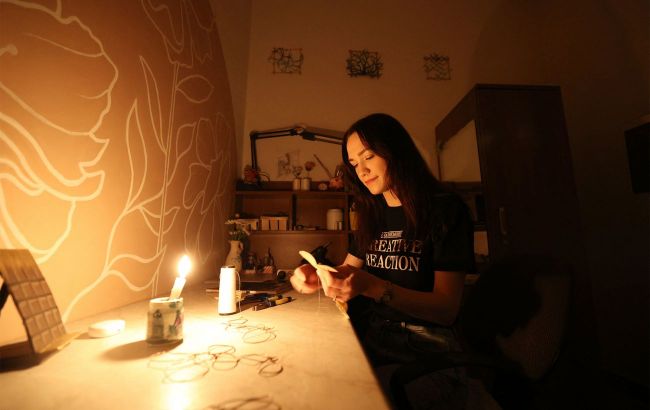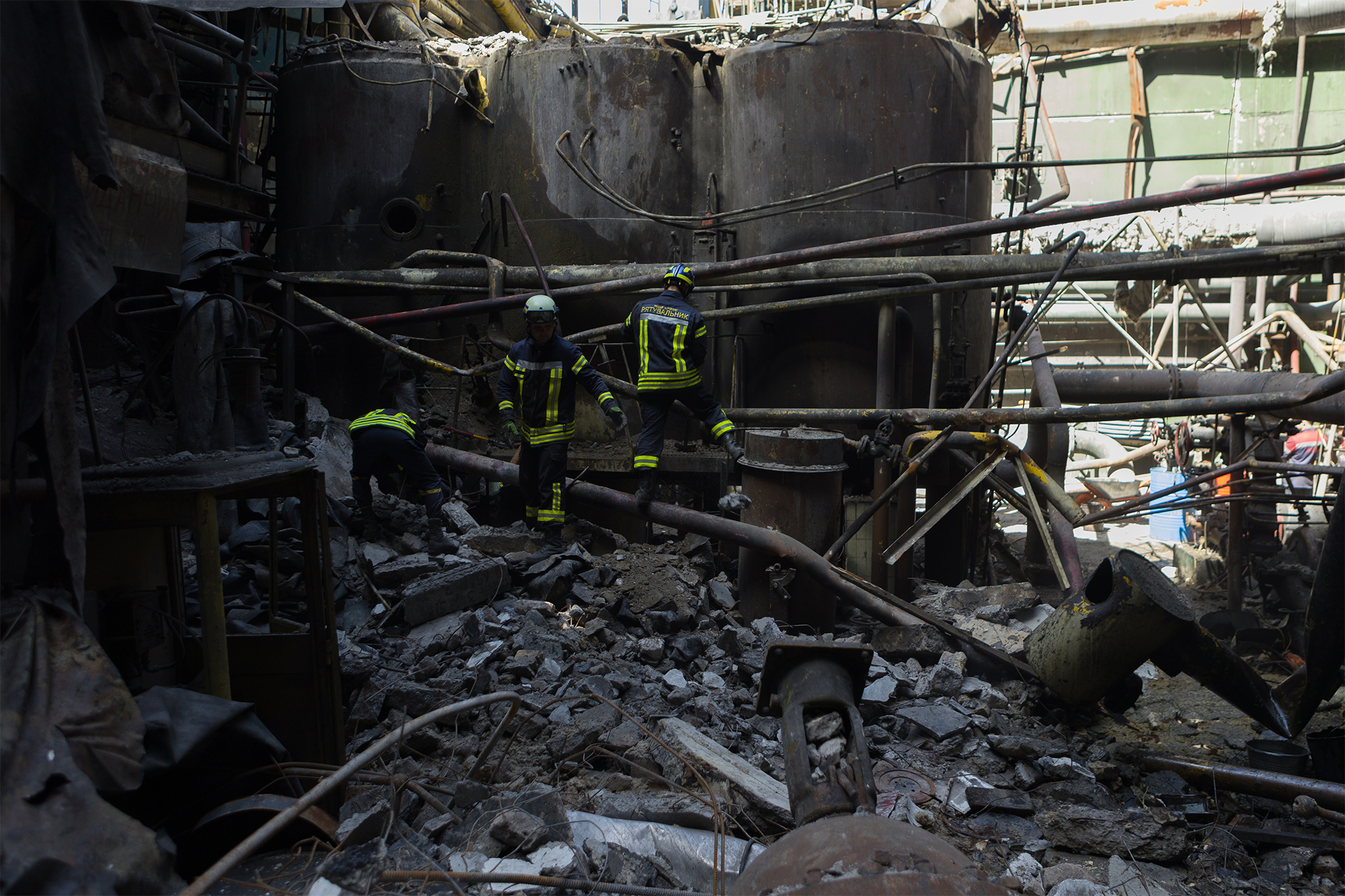Two years of rolling blackouts: How Ukraine preparing its energy sector for winter and future challenges
 Power outages in Ukraine could last for two years (photo: Vitalii Nosach, RBC-Ukraine)
Power outages in Ukraine could last for two years (photo: Vitalii Nosach, RBC-Ukraine)
After the Russian attacks, Ukraine's power system lost 9 GW. Now the only thing to do to keep the lights on for as long as possible is to save energy. To ensure that blackouts are equal across all regions, Ukraine needs to change the methodology of implementation.
Contents
- How realistic is increasing energy generation
- Situation will improve in two years
- New approach to blackouts
More than 9 GW of power generation capacity in Ukraine has already been lost after Russian troops destroyed energy facilities. It is important to increase the existing capacities by 2.5 GW before the start of the heating season. But, according to Oleksandr Kharchenko, director of the Energy Industry Research Center, this is unlikely.
By purchasing small gas turbine and gas piston power plants, a maximum of 80 MW can be restored. In his opinion, it will be possible to restore the destroyed generation up to 2 GW. But there are high risks that the restored facilities will be attacked by Russians again.
Hennadii Riabtsev, director of the Psycheya Center, is more optimistic in his forecasts. He believes that by installing small generating capacities, it will be possible to generate up to 1.5 GW of electricity. Plus, the aforementioned 2 GW will be generated by restoring the destroyed facilities.
But the losses are still more significant. Ukraine has lost most of its maneuverable generation. Two hydroelectric power plants have been decommissioned, and only 27% of all thermal power plants are in operation. Returning into operation of the lost TPPs is unlikely due to the lack of funds, necessary equipment, and poor prospects for this form of generation.
The EU has long been focused on a green approach to energy, which is aimed at reducing carbon dioxide and other greenhouse gas emissions. Decarbonization is the main topic in the energy sector. It is for green projects that Ukraine can obtain loans. It is difficult to get money from European banks to rebuild thermal power plants. So far, Ukrainian banks are trying to find loans for construction projects of small generation facilities.
To repair damaged facilities, Ukraine has to look for used equipment in Europe. Speaking at a conference on Ukraine's recovery in Germany on June 11, Volodymyr Zelenskyy called on partners to help.

A Ukrainian energy facility destroyed by a Russian missile (photo: Getty Images)
"We need to restore the (energy - ed.) facilities quickly and cheaply before winter - in 3-4 months. We know how to do it. And we ask you to equip the shutdown power plants and provide direct financial support. This will allow us to respond to the situation immediately and preserve normal life,” he said.
How realistic is increasing energy generation
Ukraine plans to build 1 GW of maneuverable thermal generation this year and another 4 GW in the coming years. "It is in this area that European and, in particular, German companies are technological leaders. It is in this area that we have a clear plan to build up to 1 GW of capacity this year and another 4 GW in the next few years. We should not talk about the future but about today. And another 4 GW in the coming years,” Zelenskyy said at a conference in Germany.
Increasing generation is still just a plan. It is not yet clear how realistic it is. Negotiations with partners are ongoing. The focus is on decentralization, i.e. on installing small generation facilities, as the risk of destruction from shelling is much lower than for large thermal power plants.
The Ministry of Energy is working on projects to develop a decentralized energy system with a focus on local distribution networks (along with GE Venona), gas piston turbines, and energy storage facilities (along with the EBRD and Siemens Electronics).
The Ministry of Energy told RBC-Ukraine that the conditions for constructing and placing gas turbine plants, block-modular boiler houses, diesel/gasoline, and gas generators (with a capacity of 1 MW or more), as well as related gas and electricity networks, will be simplified.
However, a tangible effect is expected only in the medium and long term. As for the current year, up to 1 GW at best can be restored by winter through decentralization. The President's Office confirmed these expectations to RBC-Ukraine.
Businesses are likely to install new generating units. If everything goes as expected, up to 1 GW of electricity will theoretically be freed up for the population. But this is not enough, Riabtsev believes.
"If we divide the volume by regions, we get 40 MW each. This is very little,” he told RBC-Ukraine. He also adds that in the current situation, it is necessary to resolve the issue of Kalush CHP, which has been suspended due to an economic dispute. “The launch of Kalush CHP will allow us to generate an additional 200 MW of electricity,” Riabtsev said.
Market participants believe that the 1 GW generation growth by the end of the year thanks to decentralization is a bit of an overestimate. However, they agree that businesses will be interested in diversification.

Power outage in Kyiv (photo: Getty Images)
Currently, Ukraine's industry consumes about 4 GW of electricity, half of which is consumed by large enterprises. They cover the deficit mainly through imports. But medium and small enterprises may be interested in decentralized generation.
"They may include retail chains, gas stations, agricultural enterprises... They all plan to build something. Only private business will be able to decentralize our generation quickly, and quickly means in two years,” said one of the interlocutors, who represents a large energy company. It will be beneficial for the companies, as they will sell their reserve capacity to the state, he said.
Situation will improve in two years
Given the expected power shortage, blackouts will continue indefinitely. It may take at least two years to resolve the problem. This period was mentioned by RBC-Ukraine sources in the President's Office, the Cabinet of Ministers, and the management of one of the largest energy companies.
Until the beginning of winter, the situation will depend primarily on the repair of power units. For example, in the first decade of June, repairs were completed ahead of schedule at one of the NPP units. On June 9, the power system even had a surplus. To balance the power system, it was necessary to limit generating energy from renewable sources (sun, wind, hydro) for several hours. But it is rather an exception.
Repairs at nuclear power plants will soon resume, meaning the electricity shortage will increase. Given that all the tools have been used to cover it, the only thing left is saving. And the government decided to start with itself. All government agencies have been instructed to stop using air conditioners. The population is also asked to use less air conditioning.
In fact, air conditioners consume a lot of electricity. Refusing to use them can save, according to various estimates given to RBC-Ukraine by the authorities, from 1.5 to 3 GW. This is almost a quarter of total summer consumption. But there is no mechanism to control the use of air conditioners. The only hope is for the consciousness of Ukrainians.
New approach to blackouts
Another step the government intends to take is to change the system of power outages. Until now, Ukrenergo has been communicating consumption limits to the regions. It was up to the regions to determine who to cut off and when. As a result, the periods of the population left without electricity varied significantly from region to region, depending on the number of critical infrastructure facilities.
At the same time, unexpected objects, such as one of the hotels in the capital, were often classified as critical, said an interlocutor at one of the energy companies. In industrial regions, the difficulty lies in the fact that enterprises that import 80% or more of electricity are not subject to blackouts, which also reduces the limits for the population.
The methodology is now being changed. Ukrenergo will notify the regions not of consumption limits, but of the volume of blackouts. In this case, all consumers (except for critical infrastructure) will be divided into 6 queues with a certain total consumption. Depending on how much consumption needs to be reduced, it will be a command to disconnect one, two, or three queues.
This mechanism has been tested since the end of last week. After its scheduled implementation on June 24, the problem of abuses in compiling lists of critical consumers will not be solved, but the cutoffs should be equal in duration and number in all regions. There will be no situations in which one region has no electricity for 7 hours in a row, while another region has no electricity for no more than 2 hours.

Ukrainians have to survive in extreme conditions (photo: Vitalii Nosach / RBC-Ukraine)
According to Deputy Energy Minister Svitlana Hrinchuk, the mechanism can be improved. "This will be a permanent approach (fair distribution of electricity - ed.). Today we are testing one approach, tomorrow - another. We analyze and see what is best to provide consumers with electricity as much as possible,” she said.
The situation with the power supply will remain tense throughout the entire period of warm weather. In September-October, it will be a little easier thanks to lower temperatures. But in November, the situation will become more complicated again after the cold snap, as consumption may increase by almost one and a half times compared to summer.
If the power generation capacity does not increase significantly by then, provided that there are no new serious damages to generation and distribution facilities, the worst-case scenario could be power outages lasting 6-8 hours in every 2 hours. But this scenario could also be optimistic.
Sources: public statements of Ukrainian officials, comments of RBC-Ukraine sources in the energy sector and specialized experts.

